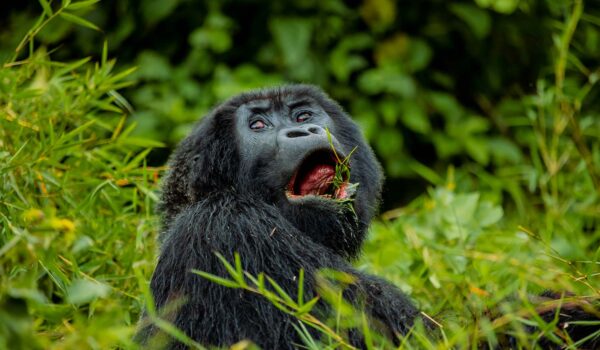Wildlife in Uganda
“Pearl of Africa,” Uganda is home to one of the continent’s most rich and diversified ecosystems. Its diverse landscapes, which include mountain ranges, broad savannahs, and thick tropical rainforests, provide an ideal habitat for a wide variety of species. Because of its biodiversity, Uganda is now one of the most popular travel destinations in Africa for scholars, conservationists, and wildlife lovers. Some of Uganda’s amazing species are unique to the country, and its dedication to sustainable tourism and animal protection has helped preserve them.
Uganda’s Mountain Gorillas
The mountain gorilla, one of Uganda’s most recognizable animals, lives in the woods of Mgahinga Gorilla National Park and Bwindi Impenetrable National Park. In the southwest region of the nation, these parks are home to about half of the world’s surviving mountain gorilla population. Because of their endangered condition, these amazing primates have garnered worldwide attention, and Uganda has worked hard to save and maintain their environment. One of the rarest and most memorable experiences of any trip to Uganda is trekking to see mountain gorillas in their native habitat. This up-close experience nurtures empathy and respect for the species by offering a remarkable chance to study their intricate social structures, relationships, and gentle nature up close.
Ugandan Primates and Other Mammals
Uganda is a popular location for primate safaris since it is home to a diverse range of primate species in addition to gorillas. Primate populations at Kibale National Park, dubbed the “primate capital of the world,” are among the highest in Africa. The main attraction of Kibale is the chimpanzees, who visitors may follow through the forest to see their interactions, communication, and foraging. Colobus, red-tailed, and L’Hoest’s monkeys are among the numerous primates that call Kibale’s lush, deep forest home, making it an unmatched place to see primates.
Uganda’s grasslands and savannahs are home to a variety of famous African animals in addition to primates. Among the many species found in Queen Elizabeth National Park, Murchison Falls National Park, and Kidepo Valley National Park are elephants, lions, leopards, and buffalos—collectively known as the “Big Five.” Furthermore, Uganda is well-known for its distinct tree-climbing lion population, which is mostly located in Queen Elizabeth National Park’s Ishasha sector and is uncommon in other lion populations.
Ugandan Birdlife
With more than 1,000 bird species known to exist, Uganda is a birdwatcher’s paradise. The diversified habitats offered by the nation’s varied terrain attract both migratory and indigenous bird species. Some of Uganda’s top spots for birding include Bwindi Impenetrable National Park, Mabamba Swamp, and Murchison Falls National Park. Found in Uganda’s marshes and wetlands, the rare and ancient-looking shoebill stork is one of the most sought-after birds. Because of its unusual look and elusiveness, the bird is a sighting that many birdwatchers want to see.
Uganda’s Conservation Initiatives
In terms of wildlife conservation, Uganda’s government and conservation groups have achieved amazing progress. The establishment of several protected areas, including as national parks and wildlife reserves, aims to preserve Uganda’s distinctive flora and fauna. Uganda’s conservation policy places a strong emphasis on community engagement, encouraging local populations to take part in ecotourism and profit from wildlife tourism. As the local populace develops a stake in protecting animals, this strategy lessens habitat damage and poaching.
In summary, the biodiversity of Uganda is evidence of its biological richness and natural abundance. In addition to providing sanctuary for threatened species, its national parks and reserves provide tourists a chance to get up close and personal with some of the most amazing creatures on the planet. From the tree-climbing lions of Queen Elizabeth to the towering mountain gorillas of Bwindi, Uganda provides a unique and immersive wildlife experience that is both fascinating and educational. In order to ensure that future generations may enjoy the delights of Uganda’s wildlife, the country works to preserve its rich biodiversity via conservation initiatives and sustainable tourism practices.
Best time for Wildlife viewing in Uganda
Dry season is the prefect wildlife viewing and general wildlife safaris in Uganda. The dry season from December to February and then June to September offer the best gorilla trekking and wildlife game drives since the trials are dry and easy to Navigate. The wet season from September to November then from March to May, have heavy rains and some of the roads are impassable as well as muddy and slippery trails. The park activities are conducted all year round although the rainy days may cause hinderances.

